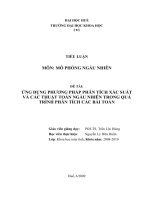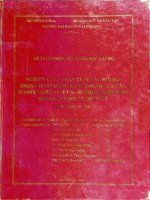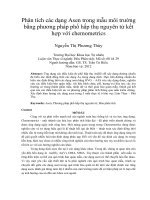Phân tích các bài đọc trong toeic 1 doc
Bạn đang xem bản rút gọn của tài liệu. Xem và tải ngay bản đầy đủ của tài liệu tại đây (62.22 KB, 6 trang )
27. In the third paragraph, the author compares cells that have been
genetically altered by biotechnicians to
(A) gardens
(B) factories
(C) hunters
(D) spotlights
28. The phrase“occupy the spotlight”in line 23 is closest in meaning to
(A) receive the most attention
(B) go the furthest
(C) conquer territory
(D) lighten the load
29. The author implies that the most important medical research topic of the
future will be
(A) the functions of the brain
(B) inherited diseases
(C) the operation of vitamins
(D) the structure of genes
Question 30-35
In the mid-nineteenth century, the United States had tremendous natural resources
that could be exploited in order to develop heavy industry. Most of the raw materials
that are valuable in the manufacture of machinery, transportation facilities, and
consumer
Line goods lay ready to be worked into wealth. Iron, coal, and oil ― the basic ingredients of
(5) industrial growth ― were plentiful and needed only the application of technical
expertise,
organizational skill, and labor.
One crucial development in this movement toward industrialization was the growth
of the railroads. The railway network expanded rapidly until the railroad map of the
United States looked like a spider's web, with the steel filaments connecting all
important
(10) sources of raw materials, their places of manufacture, and their centers of distribution.
The railroads contributed to the industrial growth not only by connecting these major
centers, but also by themselves consuming enormous amounts of fuel, iron, and coal.
Many factors influenced emerging modes of production. For example, machine
tools, the tools used to make goods, were steadily improved in the latter part of the
(15) nineteenth century ― always with an eye to speedier production and lower unit costs.
The products of the factories were rapidly absorbed by the growing cities that sheltered
the workers and the distributors. The increased urban population was nourished by the
increased farm production that, in turn, was made more productive by the use of the
new farm machinery. American agricultural production kept up with the urban demand
(20) and still had surpluses for sale to the industrial centers of Europe.
The labor that ran the factories and built the railways was recruited in part from
American farm areas where people were being displaced by farm machinery, in part
from Asia, and in part from Europe. Europe now began to send tides of immigrants
from eastern and southern Europe ― most of whom were originally poor farmers but
(25) who settled in American industrial cities. The money to finance this tremendous
expansion of the American economy still came from European financiers for the most
part, but the Americans were approaching the day when their expansion could be
financed in their own “money market”
30. What does the passage mainly discuss?
(A) The history of railroads in the United States
(B) The major United States industrial centers
(C) Factors that affected industrialization in the United States
(D) The role of agriculture in the nineteenth century
31. Why does the author mention “a spider's web” in line 9?
(A) To emphasize the railroad's consumption of oil and coal
(B) To describe the complex structure of the railway system
(C) To explain the problems brought on by railway expansion
(D) To describe the difficulties involved in the distribution of raw materials
32. The word “themselves” in line 12 refers to
(A) sources
(B) centers
(C) railroads
(D) places
33. According to the passage, what was one effect of the improvement
of machine tools?
(A) Lower manufacturing costs
(B) Better distribution of goods
(C) More efficient transportation of natural resources
(D) A reduction in industrial jobs
34. Which of the following is NOT true of United States farmers in the
nineteenth century?
(A) They lost some jobs because of mechanization
(B) They were unable to produce sufficient food for urban areas.
(C) They raised their productivity by using new machinery.
(D) They sold food to European countries
35. The word “ran” in line 21 is closest in meaning to
(A) operated
(B) hurried
(C) constructed
(D) owned
Question 36-44
The concept of obtaining fresh water from iceberg that are towed to populated areas
and arid
regions of the world was once treated as a joke more appropriate to cartoons than real
life. But
now it is being considered quite seriously by many nations, especially since scientists
have
Line warned that the human race will outgrow its fresh water supply faster than it runs out of
food.
(5)
Glaciers are a possible source of fresh water that have been overlooked until recently.
<A>
Three-quarters of the Earth's fresh water supply is still tied up in glacial ice, a
reservoir of
untapped fresh water so immense that it could sustain all the rivers of the world for
1,000 years.
Floating on the oceans every year are 7,659 trillion metric tons of ice encased in 10,000
icebergs
that break away from the polar ice caps, more than ninety percent of them from
Antarctica. <B>
(10)
Huge glaciers that stretch over the shallow continental shelf give birth to icebergs
throughout the year. Icebergs are not like sea ice, which is formed when the sea
itself freezes ; rather, they are formed entirely on land, breaking off when glaciers spread
over the sea. As they drift away
from the polar region, icebergs sometimes move mysteriously in a direction opposite to
the wind,
pulled by subsurface currents. Because they melt more slowly than smaller pieces of ice,
icebergs
(15)
have been known to drift as far north as 35 degrees south of the equator in the Atlantic
Ocean. <C>
The difficulty arises in other technical matters, such as the prevention of rapid
melting in
warmer climates and the funneling of fresh water to shore in great volume. But even if
the
icebergs lost half of their volume in towing, the water they could provide would be far
cheaper
than that produced by desalination, or removing salt from water. <D>
36. What is the main topic of the passage?
(A) The movement of glaciers
(B) Icebergs as a source of fresh water
(C) Future water shortages
(D) The future of the world's rivers
37. The word “arid” in line 1 is closest in meaning to
(A) anhydrous
(B) fruitful
(C) remote
(D) distant
38. The word "it" in line 3 refers to
(A) an iceberg that is towed
(B) obtaining fresh water from icebergs
(C) the population of arid areas
(D) real life
39. According to the author, most of the world's fresh water is
to be found in
(A) oceans
(B) rivers
(C) glaciers
(D) reservoirs
40. The word “currents” in line 14 is closest in meaning to
(A) pulls
(B) waves
(C) weather
(D) flows of water
41. How are icebergs formed?
(A) They break off from glaciers
(B) Seawater freezes
(C) Rivers freeze
(D) Small pieces of floating ice converge
42. With which of the following ideas would the author be likely to agree?
(A) Towing icebergs to dry areas is economically possible.
(B) Desalination of water is the best way to obtain drinking water.
(C) Using water from icebergs is a very short-term solution to water shortages.
(D) Icebergs could not be towed very far before they would melt.
43. Which of the following is the best place where the sentence
"To corral them and steer them to parts of the world where they are
needed would not be too difficult."
will most properly fit ?
(A) <A>
(B) <B>
(C) <C>
(D) <D>
44. The word "that" in the last line refers to
(A) the volume
(B) the water
(C) the iceberg
(D) the towing
Question 45-50
Surrounding Alaska on all but one side are two oceans and a vast sea, giving this state
the
longest coastline in the United States. In fact, if the coastlines of all of its peninsulas and
islands are considered, Alaska has a longer coastline, 33,904 miles (54,563 kilometers),
than all
Line the other 49 states together.
(5) Most of the state lies on a peninsula, bounded by the Arctic Ocean to the north, the
Bering
Sea to the west, and the Pacific Ocean on the southwest, south, and southeast. This
peninsula, stretching away from the rest of North America, forms the northwest corner of
the continent.
One of the world's largest peninsulas, it is partly shared with Canada on the east.
The seas indent the shores of the main peninsula to form other peninsulas that
contribute
(10) some of the most outstanding features to Alaska's outline. Most notable of these is the
Alaska Peninsula. The peninsula itself is 550 miles (885 kilometers) long,
before the spectacular chain
of islands reaches toward Asia.
Another of Alaska's large peninsulas is Seward, in which a number of smaller eastern
states could be swallowed up. The Kenai Peninsula, less extensive than Seward, is
about the size of
(15) the state of Maryland.









